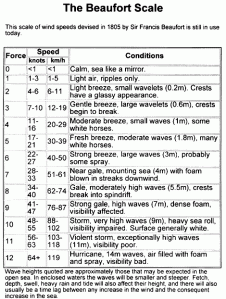Posted on February 25, 2010 by everydaysailor
The wind enables a sailboat to move through the water by supplying a force that is captured by the sails. The wind allows the vessel to sail every direction except directly into the wind. Before you get ready to harness the wind on your sailboat, make sure you understand the different attributes of the wind by reading this post.
During your time on the water, it’s important to constantly check where the wind is coming from. Any change in wind speed and direction may indicate a change in weather, and/or a change in how you are sailing your boat. Knowing that it is difficult to maneuver your boat into the directly into the wind, you should plan your sail so you are not sailing on this difficult point of sail when you are headed back to the dock for the day.
A general rule is that the closer your boat is pointed to where the wind is coming from, the closer your sails should be trimmed to the center of your boat. When you are sailing away from the wind your sails should be let all the way out. In very general terms, you should trim your sails so that each sail is as perpendicular to the direction of the wind as possible. You can tell your sails are trimmed correctly because they are not luffing (shaking). To assure your sails are trimming correctly, ease your sails out until they luff and then pull them back in just until the stop shaking. To learn more about trimming your sails, check out the posting on the Points of Sail.
Filed under: Fundamentals, Ocean, Air and Stars | Tagged: sailing, weather, wind | Leave a comment »
Posted on February 24, 2010 by everydaysailor
Wind is what makes a sailboat move through the water. Understanding how to best use the wind is a skill that every sailor should continuously practice. There are several attributes that are important to know about the wind. First, at any given moment, the wind has a true direction and a true speed. Minute to minute and even second to second, the wind changes speed and direction with small gusts and calm periods. Some days are especially gusty and it is important to notice that these gusts generally reflects a change in both speed and direction. The Beaufort Scale (shown below) is a commonly used tool to describe wind speed over the water.
In addition to the true wind, there is also an apparent wind direction and an apparent wind speed. The apparent wind takes into account both the true wind as well as the direction and speed of your boat. For example, if you are steering your boat directly away from the wind at 3 knots and the wind is blowing 10 knots, your apparent wind is 7 knots (this is the wind speed you would feel onboard your boat). The same concept is true with wind direction, the apparent wind direction not only accounts for the wind speed, but also the direction your boat is moving in relation to the direction of the wind. When you are moving on the water it is often difficult to determine the true wind direction and speed. To best determine the wind direction try using stationary objects, such as flags and trees on land. If you are out of sight of land, observe the direction of the wind on the water: spray and even small wavelets will help you determine the true wind direction.

Source: BBC
Filed under: Ocean, Air and Stars | Tagged: weather, wind | 1 Comment »
Posted on February 18, 2010 by everydaysailor

The vessel Robert C. Seamans was built by Sea Education Association (SEA) in 2001 as a state of the art sail training/scientific research vessel. The 134 foot steel brigantine primarily runs college study abroad programs in the Pacific Ocean. The 300 ton vessel is equipped with bathymetric equipment, high-tech sampling equipment, and a wet and dry lab.
The vessel, named for a former Chairman and member of SEA’s board, runs programs jointly with her sister ship, the Corwith Cramer. Students spend 6 weeks onshore and six weeks at sea studying oceanography, nautical science, and maritime studies. For more information on this program and the vessel, visit the SEA website.
Filed under: Legends and Literature | Tagged: Robert C Seamans, tall ship | Leave a comment »
Posted on February 18, 2010 by everydaysailor
The exact way you rig your sailboat depends on the type of sailboat, but no matter what, there are some basic thoughts you should consider. When you rig a sailboat, you put on and raise the sails, and in some cases put in the centerboard, rudder and tiller.
Before you get started, you will decide whether you are going to rig your boat at the dock, or motor away from the dock and rig your boat on the water. Either way, the best position to rig your boat is with the bow pointed towards where the wind is coming from. This is allows you to raise the sails without the wind catching them when you are still at the dock. If it is not possible to raise the sails while the boat is directed at the wind, you can ease the sheets to keep the sails from filling.
In most situations, it is best to completely prepare the boat in everyday before you raise the sails. This includes putting in the centerboard, placing the rudder on the stern of the boat and attaching the tiller, and bending on (attaching) all the sails. Since each boat is different I won’t go into detail as to how to rig each boat, but this basic instruction should give you a good idea of how to get started.
Filed under: Fundamentals | Tagged: Learning to sail, rigging a sailboat | Leave a comment »
Posted on February 17, 2010 by everydaysailor
Tacking
A sailboat can sail in every direction except straight into the wind. In order to sail in the direction the wind is coming from, you need to sail as close to the wind as possible and tack your boat as shown in the diagram below.

When you tack a boat, you turn the boat so that the bow passes through the wind and the sails switch from one side of the boat to the other side. It is important to practice tacking until you can smoothly maneuver your boat quickly through a tack.
When you are first learning to tack, start with your boat in a close hauled position (see the post on the points of sail if you aren’t sure how to do this). Before you tack it is important to know which way the wind is coming from and to be aware of any obstacles you may encounter when you turn your boat.
- Alert your crew of your intentions to tack by calling out the command: “ready about.” When prepared, your crew should respond “ready.”
- You are now ready to tack. Call out the command: “Helms-a-lee.” And turn the boat sharply into the wind (if steering with a tiller, push the tiller towards the sails).
- As the boat turns into the wind, the sails will luff and will pass across the boat to the other side. If you have a jib you will need to pass the sail by bringing in the lines on the leeward side of the boat and easing the sides on the windward side.
- Once your sails have passed, straighten out your steering and adjust your sails to you new point of sail. Make sure you are aware of any new obstacles on your new point of sail.

Filed under: Fundamentals | Tagged: basic sailing, tacking | Leave a comment »








